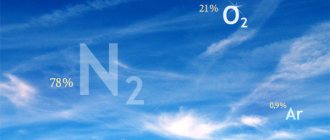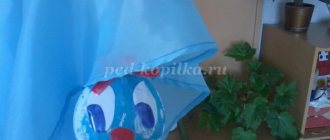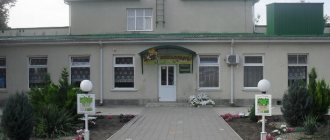Summary of GCD in the preparatory school group "Air"
Transcript
1 Municipal preschool educational institution Combined kindergarten 17 Abstract of the educational activity in the preparatory school group “Air” Prepared by teacher L.N. Khlebnikova. Lipetsk
2 Goals: to develop cognitive activity in the process of experimentation. introduce the properties of air (invisible, colorless) and its significance for all living things. continue to learn to answer in detailed sentences. activate speech and enrich children's vocabulary. cultivate the desire to independently draw conclusions and put forward hypotheses. Vocabulary work: invisible, colorless, air, bubbles, stream of air, breeze. Materials and equipment: balloons. surprise box. map. drawings-tips. containers with water. glasses. tubes. cards with tasks according to level of development. towel. boats. oilcloth large and small. fan. 2 inflated balloons. record player. Progress of the lesson B. Today two balloons flew to us. And their names are Ah and Oh. One is cheerful, elastic, big, and the other is small, thin and sad. Guys, why do you think the second ball is small? D. There is no air in it, it is deflated. (Repetition) Q. What needs to be done to make the ball round and elastic? (Individual survey) D. Inflate harder Q. What do you think will be inside the ball after we inflate it? D. Air (Individual and choral repetition) Q. Where does air come from? D. We exhale it (Individual and choral repetition) B. Let’s try to inhale and exhale air together. Now place your palm to your mouth, take air into your mouth and exhale (Children do)
3 Q. How did you feel? D. Air movement (Individual repetition) Q. Guys, balloons didn’t just fly to visit us, they invite us on a journey. Do you want to travel? D. Yes, we do. Q. There is a map here. The map shows the path we should follow. And the balls ask us to pay attention to the clue pictures and complete the tasks. Well, are you ready? We got ready, circled and we found ourselves at the beginning of the path. We need to look at the map correctly, we started the journey. What's the clue here? D. Surprise. Q. So we are on the right track. Let's reveal a surprise. Here guys, there are balls. What to do with them? Experiment 1. Inflate the balloons until they become round and elastic. To preserve the air, squeeze the ball with your fingers. (Children do) This task we have completed. Let's move on. Hold the balls tightly so they don't fly away. What's the clue here? D. Water. What is the task here? Experiment 2. There are bowls of water in front of you, lower the balls with the hole down, slowly unclenching your fingers. What appeared in the water? D. Bubbles. (Repetition) Q. Where do they come from? D. Air comes out of the balls and bubbles appear in the water. (Repetition) Q. Did you complete the task? D. We did it. V. Let's move on. What's the clue here? D. A glass with a straw. B. Correct. Now we will find out what task awaits us. Experiment 3. Take a tube, blow into it, place your palm. (Showing) How did you feel? D. a stream of air.
4 Q. Now inhale a stream of air into the tube lowered into the water. What's happening? D. The bubbles coming out are air. (Repetition) Q. This means that air comes out of both the tube and the ball, which we first inhale and then exhale. What comes out of the tube and from the ball? (Repetition) And we completed this task. Let's move on. What's the clue here? D. Eyes. So, now you and I will rest. Guys, look what is around us? D. Tables, books, furniture. (Eye exercise) Look left, right, up, down. Indeed, we are surrounded by a variety of furniture, toys, and books. Have you rested? We follow further along the map. What's the clue here? D. Veer. Experiment 4. Q. Let's sit down on the palace and find out the task. Take the fan and wave it in front of you. How did you feel? D. Breeze. (Repetition) Q. How does it arise? D. It is air that moves. Q. So, what is there besides furniture and toys around us? D. Air. (Repetition) Q. Why does a person need it? D. To breathe. (Repetition) Who else is it for? D. Animals, plants. Q. Tell me, do you see the air around us? D. No, we don’t. Q. What do you think the air is like? D. Invisible, colorless. (Repetition of individual, choral.) V. And they coped with this task. Let's move on. What's the clue here? D. Card. B. Correct. Now we will find out what task awaits us. Look carefully at the card, cross out the extra drawing that does not need air. (Children perform, we check individually, children explain their choice)
5 V. Look at the map. An airplane is drawn here. Imagine that you are airplanes. To take off, you need to inhale as much air (fuel) as possible. Sigh! Now let's fly! The wings of the planes sway, the planes fly smoothly and beautifully. But the air (fuel) runs out, and the planes land at the airfield in the port. We head to the boat clue drawing. (Children sit at the tables. I turn on the music) Guys, what do you hear? D. The sound of the sea. V. The wind is blowing across the sea, raising waves. Now sit down nicely, with your backs straight. Imagine that you are real captains and your ships are in front of you. What task awaits us? Experiment 5. B. Lower the boats into the water. Look, are they floating or standing still? D. They stand still. Q. What can we do to make the boats sail? D. Blow on them. B. Let's blow. What moves our boats? D. Air. (Repetition) Q. Where does the air come from? D. We exhale it. Q. What needs to be done to make the boats sail faster? D. Blow harder. B. Now take a deep breath, draw in the air and exhale quickly. Did the boats sail faster? Happened?! Our journey ends. I see the last clue on the map. It is written to play an interesting game “inflate the bubble”. Let us feel how we swell when we inhale air, and how we contract when we exhale air. Round dance game "Blow up the bubble." The children and the teacher join hands and form a small circle, standing close to each other. Together they say: Blow up, bubble, Blow up, big, Stay like that, Don’t burst. The players step back and hold hands until the teacher says: “The bubble has burst!” Then they let go of their hands and squat down, saying: “Clap!” You can also invite the children, after the words “the bubble burst,” to move towards the center of the circle, still holding hands and
6 while pronouncing the sound “sh-sh-sh” the air comes out. Then the children inflate the bubble again and move back, forming a large circle. Our journey has now ended. Let's say thank you to balloons? D. Yes. Q. Please tell me what surrounds us besides furniture, toys, books? (Children's answers) Who can't live without air? (Children's answers) Does air have color? D. No, it does not. It is colorless. (Repetition) Q. Do we see him? D. No, we don’t. Q. What is he like? D. Invisible. Well done! You understood everything correctly. Then inhale more air and inflate your balloons so that they become round and cheerful.
Ecology lesson notes “The air around us”
Integration of educational areas: “Cognition”, “Music”, Physical Culture”, Communication”, Socialization”, “Health”, “Artistic Creativity”.
Purpose: to generalize and clarify children’s knowledge about air; consolidate basic ideas about the sources of air pollution, the importance of clean air for our health, and some rules of environmental safety.
Objectives: - Develop thinking, memory, speech, interest in cognitive activity; the ability to express assumptions and opinions. — Exercise in correct foot placement, coordination of movements, marching skills, walking on toes. — Arouse interest in completing tasks together, create a friendly attitude. — To instill in children a caring attitude towards the world around them.
Equipment and materials: emblems/blue and pink balloons, according to the number of children, 4 glasses of water, 4 straws, 4 paper napkins, a lump of earth, pebbles, easel, cards on the topics: “How a person uses air”, “Clean and dirty city", cards with activities for cleaning indoor air, air properties; tape recorder, recording: wind noise, songs: words by V. Lebedev-Kumach, music by I. Dunaevsky “Cheerful Wind” and words by N. Olev, music by M. Dunaevsky “Colorful Dreams”, jar of water, balloon on a stick.
Preliminary work: conducting a series of classes about air, elementary experiments to get acquainted with the properties of air, showing a presentation, research walks, observations, excursions, an exhibition of drawings on the topic “Environmental Protection Sign”, memorizing poems, riddles and proverbs about the wind.
Progress of the lesson
Balloon appears (a blue ball with a face drawn on it). The children are on the carpet, standing.
— Hello guys, I'm Balloon. I came to you from a country called Air for help. Residents of our country are concerned about environmental protection on our planet, on planet Earth. And most importantly – about protecting the air on our planet. Residents of our country want to know what you know about our country, which is called Air. What to do to keep the air clean? What do you know about the importance of clean air for our health? Is wind good or bad?
Recording “wind noise”: The balloon is carried away by the wind.
Educator: Children, Balloon was blown away by the wind, let's go in search of him, we need to help him and tell him about everything he asked us about. The road will be long and difficult. Challenges await us along the way.
To the recording of the song “Cheerful Wind,” children approach an easel with diagrams of some properties of air (crossed out nose, mouth, colors, eyes).
I test:
Educator: Children, look at the picture diagrams. Explain what properties air has.
Children: Air is invisible, transparent, colorless, odorless, tasteless.
Educator: Well done, you completed the task. It's time for us to continue our journey.
To the recording of the song “Cheerful Wind,” children walk along a corrective path with “paws.”
Test II: Educator: Children, you have attached badges-emblems of balloons of two colors. Divide into two teams depending on the color of the badge balls and go to the tables on which the equipment for experiments is located.
Educator: Children, you are faced with the following task: try to detect air through experiments.
Team 1 puts the tubes into a glass of water and blows into it. Team 2 puts a pebble, a lump of earth, or a sponge into a container of water.
Educator: Children, explain what you did and proved with your experiments.
Children of the first team: We took the tubes, put them in glasses of water and started blowing into the tubes. Bubbles formed on the surface of the water. This proves that there is air in the water.
Children of the second team: We took a lump of earth, a pebble, a sponge and lowered it all into the water. We noticed that air bubbles appeared in the water. This proves that there is air in the earth, pebbles, and sponges.
Educator: Children, do we have air in us? (the teacher hands out cut strips of paper). Blow on the leaves. What happens to the leaves? Why do the leaves bend?
Children: When we exhale, air (carbon dioxide) comes out of the lungs. The air moves the leaf, so the leaf tilts. This proves that we also have air inside us.
Educator: Children, what is wind?
Children: Wind is the movement of air.
Show how you can feel the movement of air.
Physical education minute:
The wind is blowing in our faces, (arms bent at the elbows, fan your face with your palms) The tree is swaying, (straight arms raised above your head, swing your arms alternately to the right and left). The wind is getting quieter, quieter, (slow down the swaying) The tree is getting lower, lower ( squat, gradually lowering your arms)
Educator: Well done children, but more difficult trials await us ahead.
To the recording of the song “Merry Wind,” children walk along jumping ropes that lead them to the next test.
III test:
Educator: Children, there are pictures in front of you on the tables (an airplane; a parachute; a mill; a fallen tree on a car; a hurricane hitting buildings; people on a hang glider; waves hitting ships in the bay; a sailboat; a man blowing on a dandelion; insects and animals ; houseplants). Take one picture in your hands and look carefully. Answer the question: is wind good or bad for humans?
Children: A fair wind is good for a person if he is on an airplane, parachute, sailboat, hang glider, ship. Wind is good for the reproduction of plants, for the breathing of living beings; people use the properties of the wind to operate the mill. The wind can be bad if it is destructive like a hurricane, it breaks trees, buildings and cars.
Educator: Well done children. You completed this task too. Let's move on.
To the recording of the song “Merry Wind,” children walk on their toes along the rings located near the board.
IV test: Educator: Children, there are two pictures on the board, depicting a smoky city and a green city. What city would you like to live in and why?
Children: We would like to live in a green city, because we need to breathe clean air, drink clean water and not pollute the environment with the air that comes out of the pipes of industrial factories.
To the recording of the song “Merry Wind,” children walk along the rings located near the board on their toes in the opposite direction.
V test: Educator: Children, there are pictures in front of you on the tables (Pictures depicting the ocean, river, forest, mountains, cigarettes, highways with cars pouring smoke from exhaust pipes; a garbage dump; a can spraying an aerosol).
Look at them carefully, one team answers the question: Where is clean air? The second team answers the question: What pollutes the air around us?
Children of the first team: Clean air is found near the ocean, rivers, forests, and mountains.
Children of the second team: Dirty air is located next to the highway, a garbage dump, near a spray can.
Educator: You coped with this task too. It’s time for us to return to the group, maybe Balloon is waiting for you and me there.
To the recording of the song “Cheerful Wind,” children walk in the opposite direction along the jumping ropes, correctional path, and approach the easel.
Educator: There is no balloon here either, and all because we have not yet answered the question “What do we need to do to clean the air in our group?”
Children: In order for the air in our group to be clean, we should ventilate the room, grow indoor plants, and clean the group (only after the children answer, pictures are hung on an easel depicting the equipment used to clean the room, an open window, a houseplant).
To the recording of the song “Colorful Dreams”, Balloon appears.
Educator: Everyone needs air, without it there is no life.
Educator: Children, you know so much about air, but children who are younger than you don’t know this yet, so let’s help them: we’ll come up with and draw signs that will help kids learn to take care of their health and the environment.
The balloon gives a gift - soap bubbles, for the children's good knowledge.
References used: 1. Nikolaeva S.N. “Young ecologist. System of work in the senior group of kindergarten. For working with children 5-6 years old,” Mosaika-Sintez, 2010. 2. Volchkova V.N., Stepanova N.V. “Lesson notes for the senior group of kindergarten. Ecology. Practical guide for educators and methodologists of preschool educational institutions,” TC “Teacher” Pedagogy of modern times, 2006. 3. Solomennikova O.A. “Environmental education in kindergarten” Mosaic-Sintez, 2009. 4. “Lesson notes on the formation of natural science concepts in preschoolers in different age groups”, Detstvo-Press Library of the magazine “Preschool Pedagogy” 2009.
Author: Zalyalieva Leysan Firdinantovna, teacher of the Municipal Autonomous Children's Educational Institution "Kindergarten No. 398 of a combined type" of the Sovetsky district, Kazan, Republic of Tatarstan
The article is published in the author's edition


